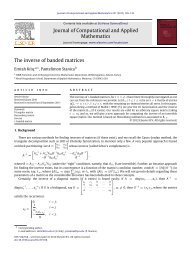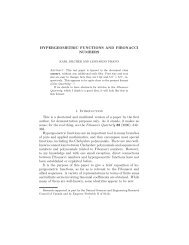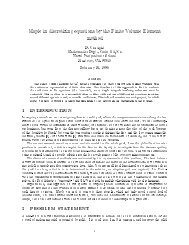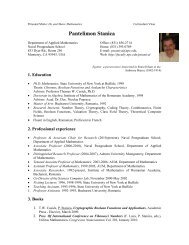Design of an Autonomous Amphibious Robot for Surf - index - Naval ...
Design of an Autonomous Amphibious Robot for Surf - index - Naval ...
Design of an Autonomous Amphibious Robot for Surf - index - Naval ...
Create successful ePaper yourself
Turn your PDF publications into a flip-book with our unique Google optimized e-Paper software.
Fig. 2. Whegs TM II flexing its body as it climbs over a curb<br />
<strong>of</strong> their axles. These mech<strong>an</strong>isms cause them to run in<br />
a nominal tripod gait, but passively adapt their gaits to<br />
irregular terrain. This compli<strong>an</strong>ce captures much <strong>of</strong> what the<br />
cockroach accomplishes with actions <strong>of</strong> its distal leg joints.<br />
The use <strong>of</strong> a single large drive motor provides a high powerto-weight<br />
ratio, making Whegs TM highly energetic, <strong>an</strong>d<br />
compli<strong>an</strong>t drive components enable passive gait adaptation<br />
over irregular terrain.<br />
Additionally, Whegs TM II, Fig. 1, incorporates a body<br />
flexion joint in addition to all <strong>of</strong> the mech<strong>an</strong>isms that were<br />
implemented in its precursor, Whegs TM I [8]. This actively<br />
controlled joint enables it to per<strong>for</strong>m both <strong>of</strong> the above<br />
posture ch<strong>an</strong>ges used by the cockroach, thereby improving<br />
its climbing ability as seen in Fig. 2.<br />
B. Objective<br />
We summarize on-going ef<strong>for</strong>ts at NPS <strong>an</strong>d CWRU aimed<br />
at the development <strong>of</strong> autonomous robotic devices capable<br />
<strong>of</strong> operations within the oce<strong>an</strong> surf zone. Part one <strong>of</strong> this<br />
project, the “<strong>Design</strong> <strong>of</strong> <strong>an</strong> <strong>Autonomous</strong> <strong>Amphibious</strong> <strong>Robot</strong><br />
<strong>for</strong> <strong>Surf</strong> Zone Operation: Part I, Mech<strong>an</strong>ical <strong>Design</strong> <strong>for</strong><br />
Mulit-Mode Mobility” [4], deals with the mech<strong>an</strong>ics <strong>of</strong> our<br />
plat<strong>for</strong>m. In this paper we report:<br />
• The development <strong>of</strong> a first generation autonomous l<strong>an</strong>dbased<br />
robot which will serve as a model <strong>for</strong> hardware<br />
<strong>an</strong>d control architectures <strong>for</strong> implementation on <strong>an</strong><br />
amphibious plat<strong>for</strong>m.<br />
• The development <strong>of</strong> a prototype mech<strong>an</strong>ical plat<strong>for</strong>m<br />
designed <strong>for</strong> arduous terrain locomotion ideally suited<br />
<strong>for</strong> amphibious operation.<br />
• The completion <strong>of</strong> a preliminary design integrating<br />
hardware <strong>an</strong>d control architectures onto the proposed<br />
amphibious locomotion plat<strong>for</strong>m.<br />
• The implementation <strong>of</strong> a dynamic simulation <strong>for</strong> robotic<br />
locomotive capability testing <strong>for</strong> design optimization.<br />
Our first goal was to develop a plat<strong>for</strong>m that would operate<br />
autonomously under waypoint navigation <strong>an</strong>d collision<br />
avoid<strong>an</strong>ce. This was done with a tracked vehicle. The <strong>Robot</strong><br />
would need to communicate in <strong>an</strong> IEEE 802.11 wireless<br />
environment, return visual data <strong>an</strong>d be able to respond to<br />
m<strong>an</strong>ual user input as required.<br />
1466<br />
Fig. 3. <strong>Robot</strong> Architecture<br />
II. FIRST GENERATION ARCHITECTURE<br />
A. Hardware<br />
Fig. 3 illustrates the architecture developed <strong>for</strong> the NPS<br />
autonomous robot. The heart <strong>of</strong> the system is based on the<br />
BL2000 WILDCAT microcontroller produced by Z-World.<br />
The BL2000 is programable in C <strong>an</strong>d has a development<br />
environment with a library <strong>of</strong> functions available <strong>for</strong> its<br />
interface ports <strong>an</strong>d Ethernet interface.<br />
The GPS <strong>an</strong>d compass components are connected via RS-<br />
232 ports. Ultrasonic sonars, with <strong>an</strong> <strong>an</strong>alog voltage output,<br />
are used <strong>for</strong> collision avoid<strong>an</strong>ce. The modem is a Netgear<br />
802.11g access point set up <strong>for</strong> UDP/IP communications.<br />
A st<strong>an</strong>dard RJ45 connection is used <strong>for</strong> this device. Motor<br />
control is realized with <strong>an</strong> <strong>an</strong>alog voltage output to a PWM<br />
circuit interfaced to <strong>an</strong> RC motor controller, this gives the<br />
robot differential motor control capabilty. Finally, our visual<br />
sensor is a st<strong>an</strong>dard DLink Web Cam, set up with a unique IP<br />
address <strong>an</strong>d connected directly to the modem. Table I gives<br />
a summary <strong>of</strong> the installed components.<br />
The components are powered by a 15 <strong>an</strong>d 6 volt (regulated)<br />
power-bus. These are supplied by a 15 volt, 11 amphour<br />
Lithium Polymer battery. The power bus <strong>an</strong>d major<br />
components are displayed in Fig. 4.<br />
The <strong>Robot</strong> was developed on a Foster-Miller Lemming<br />
tracked plat<strong>for</strong>m. Fig. 5 gives a <strong>for</strong>ward view illustrating the<br />
layout <strong>of</strong> the key sensors. The camera is mounted <strong>for</strong>ward <strong>of</strong><br />
the Garmin GPS receiver while the sonar array is mounted<br />
in the robot superstructure as shown.<br />
TABLE I<br />
ROBOT PARTS SUMMARY<br />
Components Model Vendor Comments<br />
Plat<strong>for</strong>m Lemming Foster Miller Differential Drive<br />
Micro-controller BL2000 Zworld Web Capable<br />
GPS GPS16 Garmin WAAS Capable<br />
Compass HMR2300 Honeywell +/- 1 Degree<br />
Sonar Ultra-30 Senix Corp 1-3 Meters<br />
Modem 802.11g Netgear Access-point










